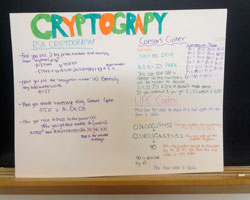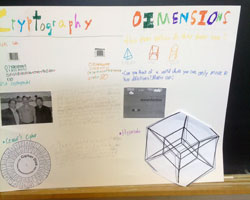Math Explorer’s Club (Grades 8–12)
Fall 2012
With support from the National Science Foundation, graduate students have developed a collection of more than 40 mathematics modules that cover a wide variety of topics accessible to middle- and high-school students.
When and Where
October 13 – November 17, 2012
Saturday mornings, 10 AM – 12:15 PM
Cornell University, Malott Hall, room 532
Current / Future Math Explorer’s Clubs
Posters Prepared by Participants



Module 1 — Number Theory and Cryptography (Fall 2012)
Ka Yue (Daniel) Wong, a fifth-year mathematics graduate student, will lead this module. Daniel completed a masters degrees in mathematics from Oxford University. He is working with Professor Dan Barbasch on his dissertation. The focus of his work is representation theory. Daniel is originally from Hong Kong. In his free time, he enjoys playing tennis and bowling.
In this module we will explore one of the oldest disciplines in mathematics — number theory. We will travel through history and look at how Euclid’s algorithm, which was developed more than 2000 years ago, has implications in the modern world of data encryption (e.g., ISBN and UPC codes).
Lesson 1: Congruence and its Applications
Lesson 2: Solving Congruence Equations I
Lesson 3: Solving Congruence Equations II
Lesson 4: Basic Group Theory
Lesson 5: RSA Encryption
Module Notes
This module borrows ideas from material developed by Jason Anema some years ago.
Module 2 — Flat Objects and Optimization (Fall 2012)
This module will be led by Laura Escobar, a third-year mathematics graduate student. Laura completed her undergraduate degree in mathematics at the Universidad de los Andes in her native country of Colombia in South America followed by a masters degree in mathematics from San Francisco State University. The focus of her dissertation is in the area of algebra and combinatorics under the direction of Professor Allen Knutson. Outside of school Laura enjoys bicycling and reading.
In this module you will learn about flat objects and apply the notion of dimension to these objects. You then will learn about optimization and the relation between optimization and flat objects, which will be generalized to three-space (the world in which we live). Finally, we will learn what happens when you want to find whole numbers solutions to optimization problems, and learn why this is interesting and much more difficult than the problems studied before!
Lesson 1: Dimension and Very Flat Objects
Lesson 2: Polygons in the Plane
Lesson 3: Introduction to Optimization
Lesson 4: Polyhedrons in 3 Space
Lesson 5: Optimization with Whole Numbers as Solutions
Module Notes
Detailed Schedule for Fall 2012
| |
10:00-11:00 |
|
11:15-12:15 |
| Oct. 13 |
Module 1 |
|
Module 2 |
| Oct. 20 |
Module 1 |
|
Module 2 |
| Oct. 27 |
Module 1 |
|
Module 2 |
|
Presentation Prep |
| Nov. 3 |
Module 1 |
|
Module 2 |
| Nov. 10 |
Module 1 |
|
Module 2 |
| Nov. 17 |
Guest Speaker |
|
Poster/Presentation Prep |
Last modified: January 24, 2013 |